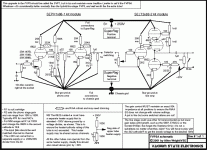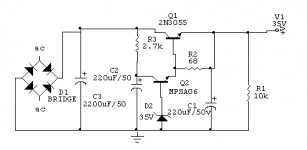ncdrawl
check out Hagerman Technology LLC: Cornet2 Vacuum Tube Moving Magnet Phonostage DIY Kit
or http://glass-ware.stores.yahoo.net/aiphprkit.html
just several phono preamps available out there
check out Hagerman Technology LLC: Cornet2 Vacuum Tube Moving Magnet Phonostage DIY Kit
or http://glass-ware.stores.yahoo.net/aiphprkit.html
just several phono preamps available out there
I just wish that someone would answer the goddamn question.
Simmer down there, sport.
but I posted a very simple question.
No you didn't. Asking for a good phono stage design is opening up a very big can of worms. There are just ESSSSSSSSSS-LOADS of phono designs out there: hollow state, solid state, and hybrids. You have designs which use NFB and designs that don't. Designs that vary from extremely simple to the elaborate. And you will find those who will swear that their favorite is "the best", and they can give you plenty of reasons as to why they think so. Others will naturally disagree.
How does anyone really know?
You might want to give This design a look-see.
What you want to do is one of the trickier things in valve/tube electronics. It took me several years to achieve a decent result, but you have a head start as you can buy Morgan Jones's book "Valve amplifiers" which has several designs and will be very helpful.
If you don't want to go down that route, you can find unstuffed pcbs from Hong Kong at reasonable prices which claim to be versions of famous commercial preamps. For instance, for $20-30 you can buy a "T Audio Phono Amplifier" which says it is based on the Matisse preamp. It only uses 2 valves/tubes (a 12AX7 and a 12AT7) but you will also have to source all the other components and build a separate 300V HT + heater voltage power supply. The circuit diagram/schematic also has to be downloaded so I should make sure about that before parting with any money.
If you don't want to go down that route, you can find unstuffed pcbs from Hong Kong at reasonable prices which claim to be versions of famous commercial preamps. For instance, for $20-30 you can buy a "T Audio Phono Amplifier" which says it is based on the Matisse preamp. It only uses 2 valves/tubes (a 12AX7 and a 12AT7) but you will also have to source all the other components and build a separate 300V HT + heater voltage power supply. The circuit diagram/schematic also has to be downloaded so I should make sure about that before parting with any money.
Hi,
Then why not build a copy of the EAR 834P?
I covered the design and some minor mods a few years ago at the Audio Asylum and following that a number of people also build their own.
EAR 834P Copy Phono Preamplifier
The text is in german, but the schematics are there.
Of course, the same person also build one of my designs and actually liked that even better than the EAR copy:
Simple Phono Preamp build #1
Simple Phono Preamp build #1
(Second link has a very nice buildup of this and links to threads here where the design originated)
On the other hand Roman "Romy The Cat" Bessnov prefers the EAR 834P realised with Air or Vacuum capacitors for the equalisation.
I would suggest not use a PCB, hard wired really does sound better.
There are several Threads on building "my" Phono Stage design, including a wooly mammoth sized one about building and debugging the design by "Kofi Annan", worth seeking out. My posts are notable under the nom du guerre "Kuei Yang Wang".
I also have a thread with a simple J-Fet Mc Pre-Pre. This comes highly recommended on bang4bucks and with the easily available 2SK389/LSK389 you can save yourself the hassle of selecting the Fet's for channel Matching
Ciao T
I enjoy the EAR products, but they are a bit too spendy for me..
Then why not build a copy of the EAR 834P?
I covered the design and some minor mods a few years ago at the Audio Asylum and following that a number of people also build their own.
EAR 834P Copy Phono Preamplifier
The text is in german, but the schematics are there.
Of course, the same person also build one of my designs and actually liked that even better than the EAR copy:
Simple Phono Preamp build #1
Simple Phono Preamp build #1
(Second link has a very nice buildup of this and links to threads here where the design originated)
On the other hand Roman "Romy The Cat" Bessnov prefers the EAR 834P realised with Air or Vacuum capacitors for the equalisation.
MC and MM preferred, need PCB Schematics, etc.
I would suggest not use a PCB, hard wired really does sound better.
There are several Threads on building "my" Phono Stage design, including a wooly mammoth sized one about building and debugging the design by "Kofi Annan", worth seeking out. My posts are notable under the nom du guerre "Kuei Yang Wang".
I also have a thread with a simple J-Fet Mc Pre-Pre. This comes highly recommended on bang4bucks and with the easily available 2SK389/LSK389 you can save yourself the hassle of selecting the Fet's for channel Matching
Ciao T
Allen Wright's hybrid cascode
Attachment from (and more examples there):
Schematics
needs a really good power supply.
dave
Attachments
 Posts about transistor history moved to: http://www.diyaudio.com/forums/parts/158490-2n2222a-transistor-transisitor-history.html
Posts about transistor history moved to: http://www.diyaudio.com/forums/parts/158490-2n2222a-transistor-transisitor-history.htmlTransistor preamp by IVey moved to new thread: http://www.diyaudio.com/forums/analog-line-level/158918-2n2222a-phono-preamp.html
Panomanic: Mr. Moderator
I joined this forum because, one of my desires was to Start a thread on building Moscode styles of power amplifiers, and to share all that information with those persons interested in being a part of that thread.
But when I tried, you directed me to threads that I felt and discovered, did not truly cover the subject, nor address the subject in its realm.
The Aikido thread dealt solely with it, not moscode styles of amplifiers.
I have schematics and diagrams to nearly every Futterman OTL and Moscode amplifier. Believe or it not, they were sent to me in 1986 by George Kaye, when I moonlighted at Counterpont Electronics in Carlsbad, Ca. We serviced a lot of various HiFI equipment there as well. I also have the Counterpoint items. Somethings, I managed to lose, or loaned out and can not remember who I gave them too.
Anyway, on the "Moscode with a thump" thread, I left a message for George Kaye, but he never came back or got back to me.
I think, he thinks that if he do not answer, people will think that I am trying to act important or that I think I got one up on everyone else.
Far from it. I just want to ask him if he will give me permission to post the stuff on the forum. Because I learned that he is still making Moscodes. And he may not not like it. And I want him as a friend, not a foe.
I am aware that I can contact him in private.Yet I want this to be public, when he tells me yes or no.
I want there to be no doubts, in the forums position, the actions that I take.
I have other designs, that I can start off with, but I would like to expose all the different topologies, on the hybrid subject. If you allow me to open this thread.
I await your reply Sir.
Take Care
Ivey
I joined this forum because, one of my desires was to Start a thread on building Moscode styles of power amplifiers, and to share all that information with those persons interested in being a part of that thread.
But when I tried, you directed me to threads that I felt and discovered, did not truly cover the subject, nor address the subject in its realm.
The Aikido thread dealt solely with it, not moscode styles of amplifiers.
I have schematics and diagrams to nearly every Futterman OTL and Moscode amplifier. Believe or it not, they were sent to me in 1986 by George Kaye, when I moonlighted at Counterpont Electronics in Carlsbad, Ca. We serviced a lot of various HiFI equipment there as well. I also have the Counterpoint items. Somethings, I managed to lose, or loaned out and can not remember who I gave them too.
Anyway, on the "Moscode with a thump" thread, I left a message for George Kaye, but he never came back or got back to me.
I think, he thinks that if he do not answer, people will think that I am trying to act important or that I think I got one up on everyone else.
Far from it. I just want to ask him if he will give me permission to post the stuff on the forum. Because I learned that he is still making Moscodes. And he may not not like it. And I want him as a friend, not a foe.
I am aware that I can contact him in private.Yet I want this to be public, when he tells me yes or no.
I want there to be no doubts, in the forums position, the actions that I take.
I have other designs, that I can start off with, but I would like to expose all the different topologies, on the hybrid subject. If you allow me to open this thread.
I await your reply Sir.
Take Care
Ivey
ivey, you confused me for a moment and then i see: i was referring the power supply in posts #27 and #28; i think you are referring to your bipolar transistor riaa preamp in posts #12 and #13?
so, for the power supply circuit from posts #27 and #28, shown below, is a resistor missing?
thanks
mlloyd1
so, for the power supply circuit from posts #27 and #28, shown below, is a resistor missing?
thanks
mlloyd1
No Sir, the 82k provides base bias for Q2, through the feedback loop. The 680 ohm resistor, 1k resistor, the 47uf/50 provides reference for the zener.
the zener is used to provide reference to Q2's gain section, because you have two feedback loops to that section. The RIAA and the negative feedback loop of the 82k resistor.
If the reference voltage is lost, the unit could go into oscillation. When current demands are present.
I have played the phono amp without the zener, and it sounds muddy. With it, it is sweet and warm for a ss unit.
Take Care
Ivey
Attachments
- Status
- This old topic is closed. If you want to reopen this topic, contact a moderator using the "Report Post" button.
- Home
- Amplifiers
- Tubes / Valves
- Need a good phono stage design..

